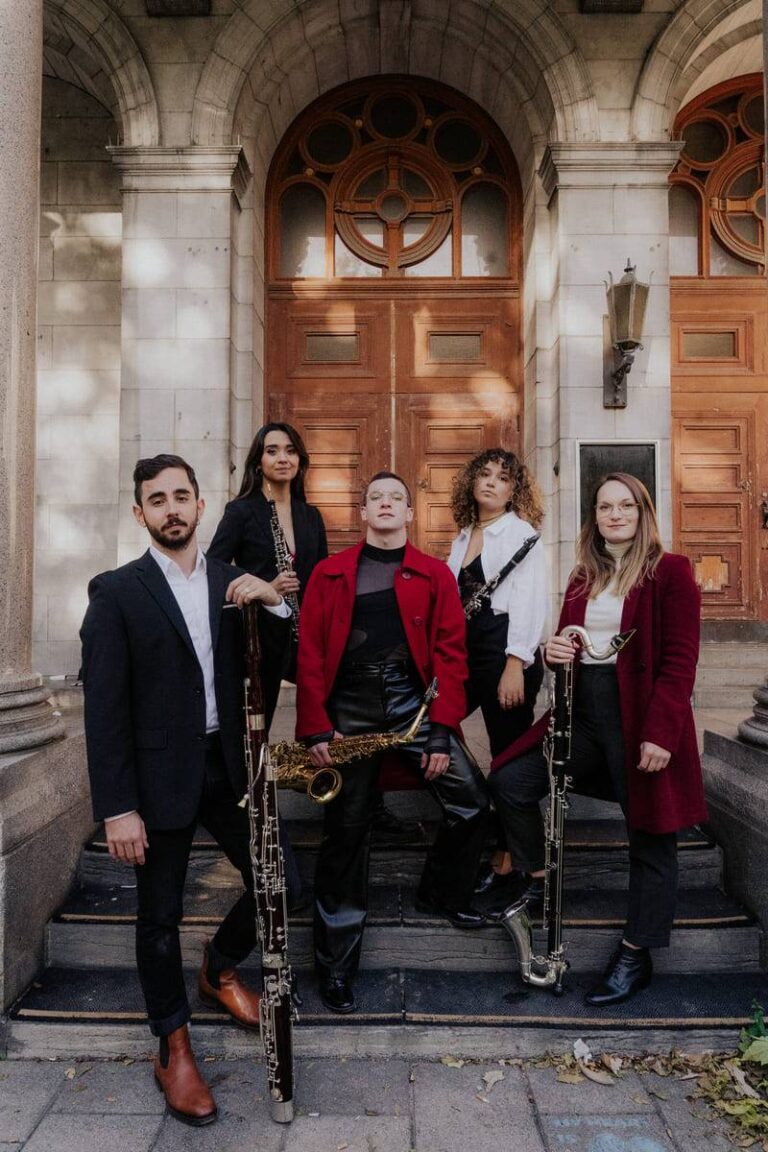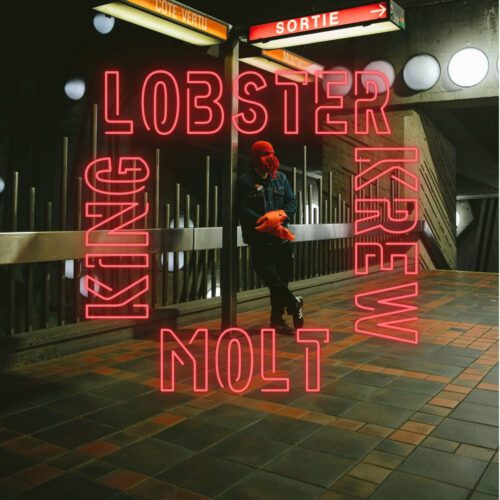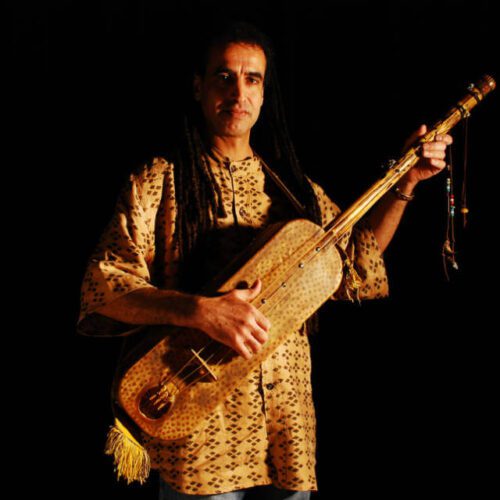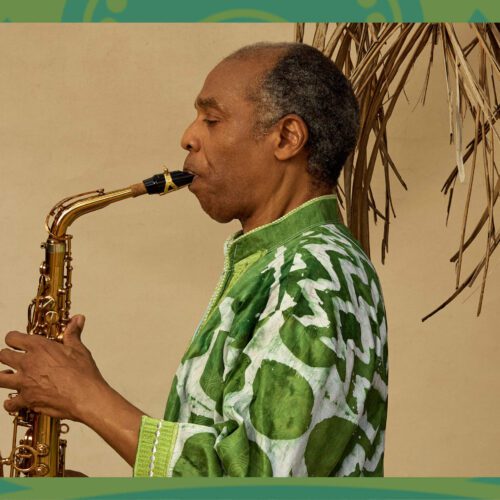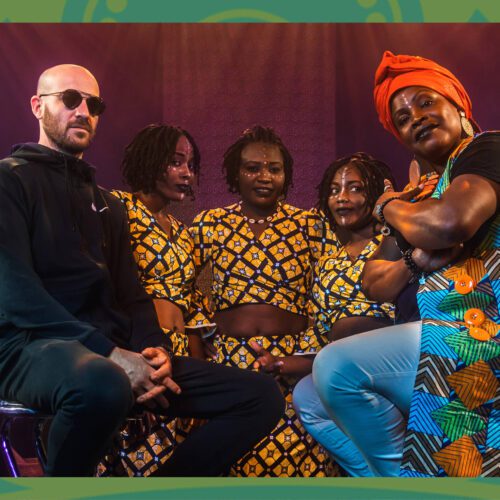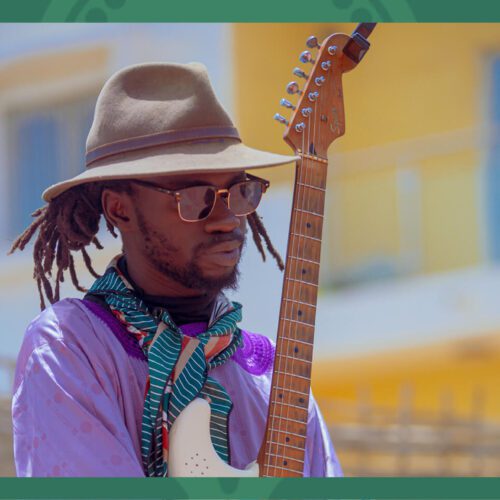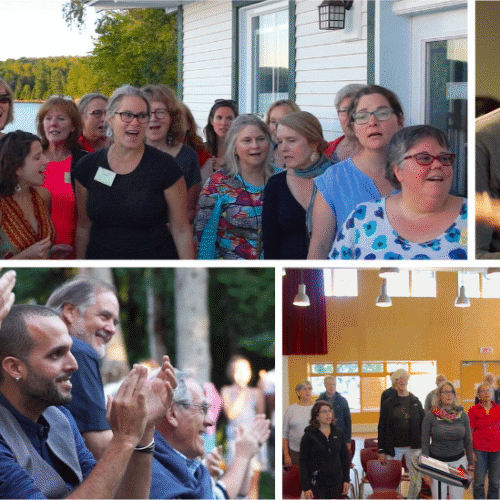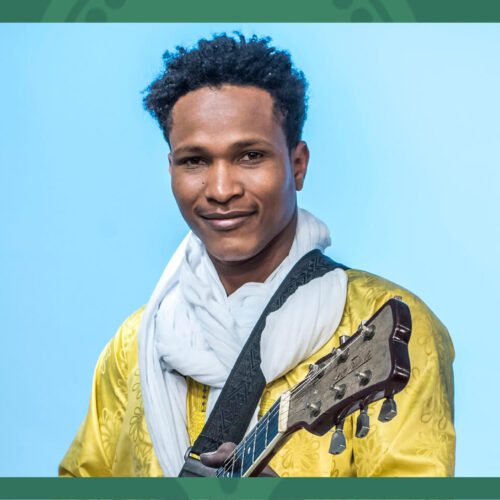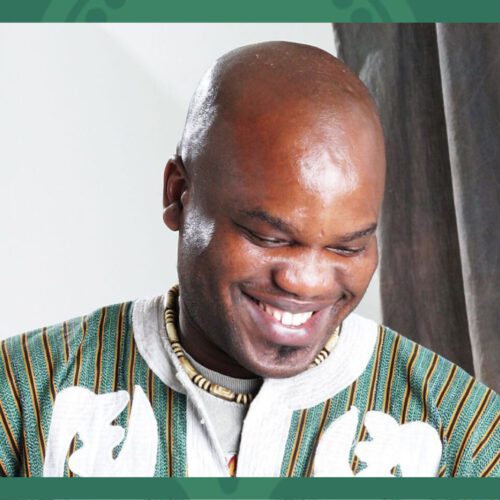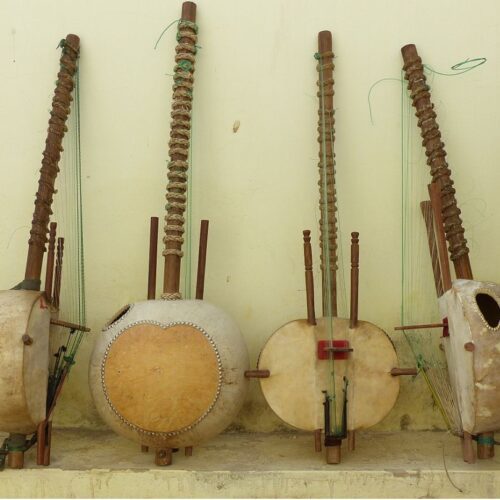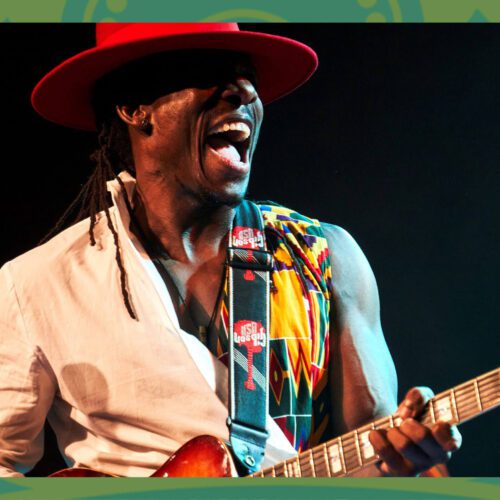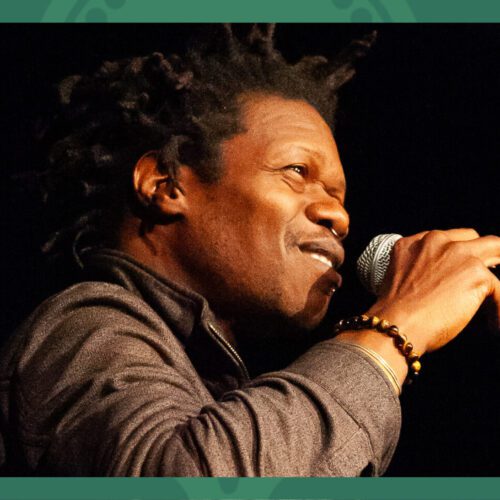Additional Information
On November 25, 2022 at La Sala Rossa, a new chamber music ensemble was born into Quebec’s musical constellation: 5ilience – pronounced “silience” – is the province’s first reed quintet. Initiated by saxophonist Thomas Gauthier-Lang, the ensemble’s founding members include Léanne Téran-Paul (oboe), Mariane Pellerin (clarinet), Gwénaëlle Ratouit (bass clarinet) and Maxime Hargous (bassoon). These five young emerging artists, trained in classes at the Conservatoire and Université de Montréal “[are] following in the footsteps of the very first reed quintet, the Calefax ensemble, born in 1985, by dedicating themselves to expanding the existing reed quintet repertoire through the development of new works by emerging and established composers.” After just a few months, the distinctive timbre of this unusual ensemble was heard at the Festival de Lanaudière, and will now be heard as part of the tenth edition of La Virée classique.
PAN M 360 sat down with two of the ensemble’s members, Thomas Gauthier-Lang, its artistic director, and Mariane Pellerin, to discuss the birth of the project and its short history.
PAN M 360: Hello to you both! Thank you for taking the time to talk to us. I’d like to start by asking Thomas how 5ilience came about, and Mariane, how did you come to work together on this ensemble project with the others?
Thomas Gauthier-Lang: For me, the 5ilience project was born during the pandemic. I’d just finished my master’s degree and returned from France, where I’d completed my second year. The pandemic was really a stopping point for me to think about what kind of music I wanted to make and with whom. As a saxophonist versed in contemporary music, I had specialized mainly in solo music, so during the pandemic, what I really missed was human contact, contact with people. At one point, I was surfing the web and found information on the first reed quintet, the Calefax ensemble. I knew a bit about the saxophonist, and after diving in and exploring this music, I really discovered a different genre and music that spoke to me a lot: music that always has an “edge”, that makes you ask questions and in front of which you can’t remain indifferent, and that is rooted in creative music. When it came to putting the idea into practice, I started talking to musicians I liked, like Mariane, whom I was lucky enough to meet at Domaine Forget one summer, and who was introduced to me by a friend she and I have in common.
Mariane Pellerin: We weren’t even doing the same internship at Le Domaine! We talked a little, but not that much. I’d just finished my master’s degree that summer, and I was thinking, “I’m going to think about my future later on”, and “You say yes to everything”, so this proposal was perfectly timed. What I particularly like about music is playing chamber music. Playing in an orchestra is fun, it’s all very well, but you really have fewer opportunities to be yourself and participate and change something in what you’re doing. I knew I wanted to do more chamber music, but I didn’t really know how, and when Thomas came to talk to me about the project, he already had a pretty precise plan of what he wanted to do. I already knew Léanne from my Conservatoire days with her, and Gwen from a non-musical background. We got on well together, so I thought “Let’s go!”
Thomas Gauthier-Lang: We’d never made music together, but on a human level, there was a kind of letting go, a letting go where things were really natural.
PAN M 360: The killer question: what does the word “silience” mean?
Thomas Gauthier-Lang: Haha, that was a lot of thought, spread over a year. A name is an image, but I think it’s also a philosophy. Sometimes, it’s neither, but for me, in the idea of making people think, the name was important. “Silience” is a word that comes from a dictionary of neologisms, John Kœnig’s Dictionary of Obscure Sorrows. He is interested in finding and creating new words to express abstract feelings and emotions, rather than summarizing them in sentences. “Silience” is an amalgam of “brilliance” and “silence”. For him, it refers to the art that’s all around us, but which we don’t realize is there and exists unless we take the time to stop and pay attention to it.
PAN M 360: So, it’s the state of mind that makes us aware of the invisible around us.
Thomas Gauthier-Lang: Exactly!
PAN M 360: As you mentioned, the repertoire includes a great deal of new music. Is it only the repertoire of new music that characterizes a reed quintet, given its unusual formation?
Thomas Gauthier-Lang: No, creative music is not the only niche. When Calefax was first created, there was no repertoire. The musicians in this ensemble did a lot of arranging. They soon realized that they shared a common interest in Baroque and medieval music, and so on. For medieval music in particular, the instrumentation wasn’t even determined, so it allows us to play with the different timbres of the modern instruments we have. Another example: last month at the Festival de Lanaudière, we played an arrangement by one of the Calefax musicians of the Chaconne from Bach’s second partita, based on Bussoni’s piano arrangement. It’s part of a long tradition of arranging.
In addition, this particular ensemble opens a call for works for male and female composers. They play these works in concert, and anything that comes out of these calls is then accessible to all reed quintets. So, they really have a mission to mediate and share the repertoire. It also influences what’s been done in the U.S. like Akropolis, which is a super-popular reed quintet that also publishes their own stuff and shares their music. These aren’t cells that don’t communicate with each other; the world’s reed quintet network talks to each other and interacts.
PAN M 360: Your formal existence is still fairly recent in terms of ensemble, and you’ve taken part in the Festival de Lanaudière, which is one of the biggest outdoor music festivals in North America, and now you’re taking part in the Virée classique, which is another major music event. For a young band and young musicians, some of whom I imagine are taking their first steps in the professional world, how does it feel to be able to take part in events of this magnitude?
Mariane Pellerin: It’s really nice. There’s an aspect where you can allow yourself to imagine things. Whether it’s international internships or major projects where we’d have said to each other, “We could do that later”, normally I’d have said, “We’ll see”. The fact of doing something concrete, of carrying out projects like this, helps us to see our ideas or future projects as accessible. It gives me security and a certain hope for the future.
Thomas Gauthier-Lang: There’s something very reassuring about thinking up a project on your own, thinking up a project with people to launch it into the universe, and then the universe seeing it and receiving it. What’s touched me the most when we get invited to events like this, is that they understand what 5ilience is all about and they understand what 5illience does for the world that hears us. I’ve always been confident in the nature of the project, but I never expected that after eight months of existence, we’d be invited to these two festivals. Often after concerts, people get very excited. They’ve never heard anything like it before, especially when you consider that these festivals are more classical repertoires. We arrive with a line-up and instruments they recognize and know, but with a language that’s a bit “crooked” and different. It takes them somewhere else, and a good somewhere else, I think. When we finish playing and we can physically see that something is happening in the audience, that we’ve succeeded in bringing something to life for someone, that’s the greatest gift.
PAN M 360: Can we have an overview of the repertoire you’ll be performing for Virée?
Thomas Gauthier-Lang: We’re painting a portrait of the history of the reed quintet, from how composition has developed around it over the years to the present day. There will be a new work by Simon Bourget (Danses galactiques), Refraction, by American composer David Biedenbender, which is like a flagship piece in the repertoire, new works by major ensembles, such as Splinter by Marc Mellits, Four Letter Word by Robbie McCarthy, as well as our own creations. We really go all over the place. It’s a festive, active, fast-paced program, both light and contemporary. We can’t wait to see how people react!
PAN M 360: What projects are you looking forward to with 5ilience in the coming months?
Thomas Gauthier-Lang: In the next few months, we’ll be welcoming our new bassoonist Alexandra Eastley, who will be joining us officially because our current bassoonist and founding member Maxime is returning to Europe to continue his studies. She’s Mary Chalk, who joined us for the Festival de Lanaudière and will also be with us for the Virée classique. We’ve got two albums coming out that we’ve played on, and with Code d’accès, we’ve got a large-scale, multidisciplinary concert with space design and video planned for spring 2024. It’s going to be something. We’re also looking to travel outside Quebec, take training courses, give concerts and so on. Also, along with 4 other artists/ensembles, 5ilience has been chosen to be part of Pôle de la Relève, a new mentoring program offered by Le Vivier to help young artists and ensembles grow and develop. I’m super excited and curious to see what comes out of it too.
PAN M 360: As the newest and youngest group to emerge on the Quebec chamber music scene, what would you say to young musicians who are just finishing up or who want to get started?
Mariane Pellerin: I find it strange and difficult to answer that because I feel that I myself am a young musician in need of advice! I’d say two things. I say it jokingly, but sometimes I say “Fake it till you make it”. Sometimes you’re not sure what you’re doing, but you’ve got to have confidence, even if you really feel like you’re messing up. Secondly, it’s about being yourself, believing in what you believe and following it. It’s about trusting your instincts.
Thomas Gauthier-Lang: I’d like to focus on three things, based on what I’ve experienced, what makes me feel good, and what I’m learning today. Firstly, I’d say look at who you’re “tripping” with, because that’s the world you’re going to want to make music with. For me, studying music or any field of art is about making connections and realizing who you’re having fun with. Secondly, not to be contradictory with Mariane, but for me, it’s been very reassuring to stop being someone I’m not. I’m a saxophonist, and for a long time I said to myself: “I’ve got to play blues, I’ve got to play bebop”. As much as I love that music, it’s not the language I resonate with most. When I stopped telling myself that the world expected me to do this as a saxophonist, I found enormous satisfaction in the kind of music I was making. In the end, if you do something you love, it’s bound to attract people. People will listen to you. Do something you like without necessarily pleasing other people. Those would be my points.
PAN M 360: Thank you both very much!
5ilience will perform on Sainte-Catherine street on August 18 at 7 pm and on August 19 at 7:30 pm. For more information, the full free programming can be found HERE.
